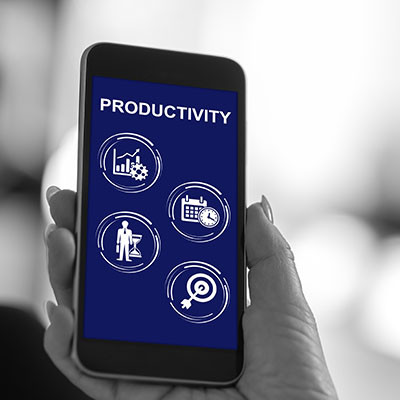Does your business view its IT as just another necessary expense? Many small businesses think of IT as a simple box to check, a cost center that eats into profits and breaks down too frequently to actually yield a return on investment. We have news for you; modern IT management gives you a means not only to maintain the status quo, but to grow into a business that remains competitive in the long term.
Accucom Blog
Historically, AI has been perceived by SMBs as complex, expensive, and outside their operational scope. Today, the democratization of AI via SaaS and integrated platforms makes it a cost-effective, practical IT asset with measurable ROI.
Here are three focused areas where AI can be strategically deployed to optimize your business performance:
Artificial intelligence has officially moved from science fiction into our daily toolkit. Whether you're drafting an email, brainstorming a new project, or debugging code, AI tools can dramatically boost productivity. Like any powerful tool, however, knowing how to use it effectively is growing in importance. This week, we thought we’d give you three tips on how to get AI to work best for your organization.
The hiring process is long and tiring, but hopefully by the end of it all, you end up with the perfect candidate for the position. While they might be eager to get to work, they might find themselves ill-equipped to do their job—a position you don’t want them to be in. Unfortunately, this is how many new hires start their tenure with a new employer, and while it might be tempting to claim that someone simply dropped the ball during the onboarding process, it’s more likely that the onboarding process itself is broken.
The concept of a four-day workweek has long been debated, with strong anecdotal evidence supporting its effectiveness. The nation of Iceland provides one of the most compelling real-world examples.
Their journey began small in 2015 with initial trials involving about 2,500 workers; or, just under one percent of the population. These efforts have dramatically expanded, however, and today, nearly 90 percent of Icelandic workers have moved to a reduced work schedule, typically around 36 hours a week for full-time workers. What’s more, this shift has occurred without any negative impact on the economy. In fact, Iceland's society has seen significant benefits.
Do you feel sluggish, achy, or just plain tired after a long day of sitting? A simple change to your workday could be the key to improving your health and boosting your well-being: the standing desk.
The popularity of standing desks is growing for good reason. They are an easy way to combat the negative effects of a sedentary lifestyle. Standing for even part of your day can make a big difference, and here are five of the top benefits you can expect.
Your business has a lot of technology at its fingertips, but how effectively are you using it? Chances are some of your tools might have more practical uses than you might expect. One such tool is Microsoft Excel, Microsoft 365’s spreadsheet building platform. Here are three ways you can use Excel for your SMB that you might not have thought about.
Resistance to new technology is a common challenge for businesses. The key to a smooth rollout isn't just about picking the right technology; it's about building a comprehensive strategy that addresses the human element of the change being made. As software is extremely important to any business, having a solid strategy in place to address the governance of your IT systems only makes sense. Today, we’ll give you a baseline on how to build one.
Do you find yourself visiting the same websites day after day for your work? This is essentially what it looks like for everyone, whether we’re working with calendars, applications, portals, or other systems. Bookmarks make this repeated navigation significantly easier, so today, we want to go over some best practices to help you get the most out of your bookmarks.
The moment when the technology you rely on suddenly stops working can be frustrating, but more than anything else, it can be expensive. If you understand these types of situations, you know that you need a plan to keep them few and far between. Let’s take a look at the costs of downtime and a few things you can do to keep it to a minimum.
Nowadays, it is especially critical for every business to optimize its operations, boosting productivity while eliminating setbacks and obstacles. The information technology available today can make this process much easier if utilized correctly.
Let's discuss a few ways to take advantage of it for your organization’s benefit.
New threats emerge each and every day, whether it’s the latest form of ransomware or a simple virus out to make your life miserable. That’s why it’s so important you take steps to protect your business. Here are the threats your business needs to watch out for, as well as what you can do to keep your organization safe.
Supercharging your productivity is all about making small, deliberate changes that create lasting impacts. Unfortunately, there is no roadmap to follow, so you will have to figure it out for yourself. In today’s blog, we talk about prioritization, time management, and focus and how they each work to help you get more done.
Running a small business often inspires dreams of rapid expansion and immediate success. However, it’s crucial to balance ambition with realistic expectations to ensure sustainable growth. In today’s blog, we’ll discuss how entrepreneurs and managers can set achievable goals while maintaining business stability.
Technology has enabled us to achieve more than ever before, but with that progress comes higher expectations. Increased productivity demands can sometimes feel overwhelming, making it essential to find effective ways to manage tasks. There's a natural limit to how much we can do, however, and certain obstacles can push us to that limit more quickly. Today, we’ll explore two common productivity pitfalls that many face.
Sometimes the simplest tips are some of the most powerful, as seen in the case of the Undo button. If you make a mistake, most Windows programs (and many other visual-based programs) allow you to undo your previous actions. Today, we want to remind you of Undo and Redo, as well as three other well-known and effective keyboard shortcuts out there.























